Today looks like a typical back test of support after an upwards breakout. The identified area of support is holding.
Targets remain the same.
Summary: An upwards breakout above 2,940 with support from volume adds confidence in the wave count. The next target is 3,120. Classic analysis very strongly supports this main wave count.
The biggest picture, Grand Super Cycle analysis, is here.
Monthly charts were last published here, with video here. There are two further alternate monthly charts here, with video here.
ELLIOTT WAVE COUNTS
The two weekly Elliott wave counts below will be labelled First and Second. They may be about of even probability. When the fifth wave currently unfolding on weekly charts may be complete, then these two wave counts will diverge on the severity of the expected following bear market. To see an illustration of this future divergence monthly charts should be viewed.
FIRST WAVE COUNT
WEEKLY CHART
The basic Elliott wave structure consists of a five wave structure up followed by a three wave structure down (for a bull market). This wave count sees the bull market beginning in March 2009 as an incomplete five wave impulse and now within the last fifth wave, which is labelled cycle wave V. This impulse is best viewed on monthly charts. The weekly chart focusses on the end of it.
Elliott wave is fractal. This fifth wave labelled cycle wave V may end a larger fifth wave labelled Super Cycle wave (V), which may end a larger first wave labelled Grand Super Cycle wave I.
The teal Elliott channel is drawn using Elliott’s first technique about the impulse of Super Cycle wave (V). Draw the first trend line from the end of cycle wave I (off to the left of the chart, the weekly candlestick beginning 30th November 2014) to the end of cycle wave III, then place a parallel copy on the end of cycle wave II. This channel perfectly shows where cycle wave IV ended at support. The strongest portion of cycle wave III, the end of primary wave 3, overshoots the upper edge of the channel. This is a typical look for a third wave and suggests the channel is drawn correctly and the way the impulse is counted is correct.
Within Super Cycle wave (V), cycle wave III is shorter than cycle wave I. A core Elliott wave rule states that a third wave may never be the shortest. For this rule to be met in this instance, cycle wave V may not be longer in length than cycle wave III. This limit is at 3,477.39.
Cycle wave V may subdivide either as an impulse or an ending diagonal. Impulses are much more common. This main wave count expects that cycle wave V may be unfolding as an impulse.
The daily chart below will now focus on all movement from the end of primary wave 1.
In historic analysis, two further monthly charts have been published that do not have a limit to upwards movement and are more bullish than this wave count. Members are encouraged to consider those possibilities (links below summary) alongside the wave counts presented on a daily and weekly basis.
DAILY CHART
Cycle wave V is seen as an impulse for this wave count.
Within cycle wave V, primary waves 1 and 2 may be complete. Primary wave 3 may have begun.
Primary wave 3 may only subdivide as an impulse. Within primary wave 3, intermediate waves (1) and (2) may be complete.
Intermediate wave (3) may have begun. Intermediate wave (3) may only subdivide as an impulse.
Within intermediate wave (3), minor waves 1 and 2 may be complete. Within minor wave 3, minute waves i and ii may be complete. Within minute wave iii, no second wave correction may move beyond its start below 2,834.97.
All of primary wave 3, intermediate wave (3), minor wave 3 and minute wave iii may only subdivide as impulses.
Intermediate wave (3) must move far enough above the end of intermediate wave (1) to then allow intermediate wave (4) to unfold and remain above intermediate wave (1) price territory.
HOURLY CHART
Within minor wave 3, minute waves i and ii may be complete. Minute wave iii may only subdivide as an impulse. Within the impulse of minute wave iii, minuette wave (i) may be incomplete.
Within minuette wave (i), subminuette waves i and ii may be complete. Subminuette wave iii may be incomplete. Within subminuette wave iii, micro wave 4 may not move into micro wave 1 price territory.
Micro wave 4 may still be a completed expanded flat. Today price bounced up off the lower edge of the best fit channel, indicating this is the current area of support correctly identified. The breakaway gap remains open.
Subminuette wave iv may not move into subminuette wave i price territory below 2,898.75.
SECOND WAVE COUNT
WEEKLY CHART
This weekly chart is almost identical to the first weekly chart, with the sole exception being the degree of labelling.
This weekly chart moves the degree of labelling for the impulse beginning in March 2009 all down one degree. This difference is best viewed on monthly charts.
The impulse is still viewed as nearing an end; a fifth wave is still seen as needing to complete higher. This wave count labels it primary wave 5.
TECHNICAL ANALYSIS
WEEKLY CHART
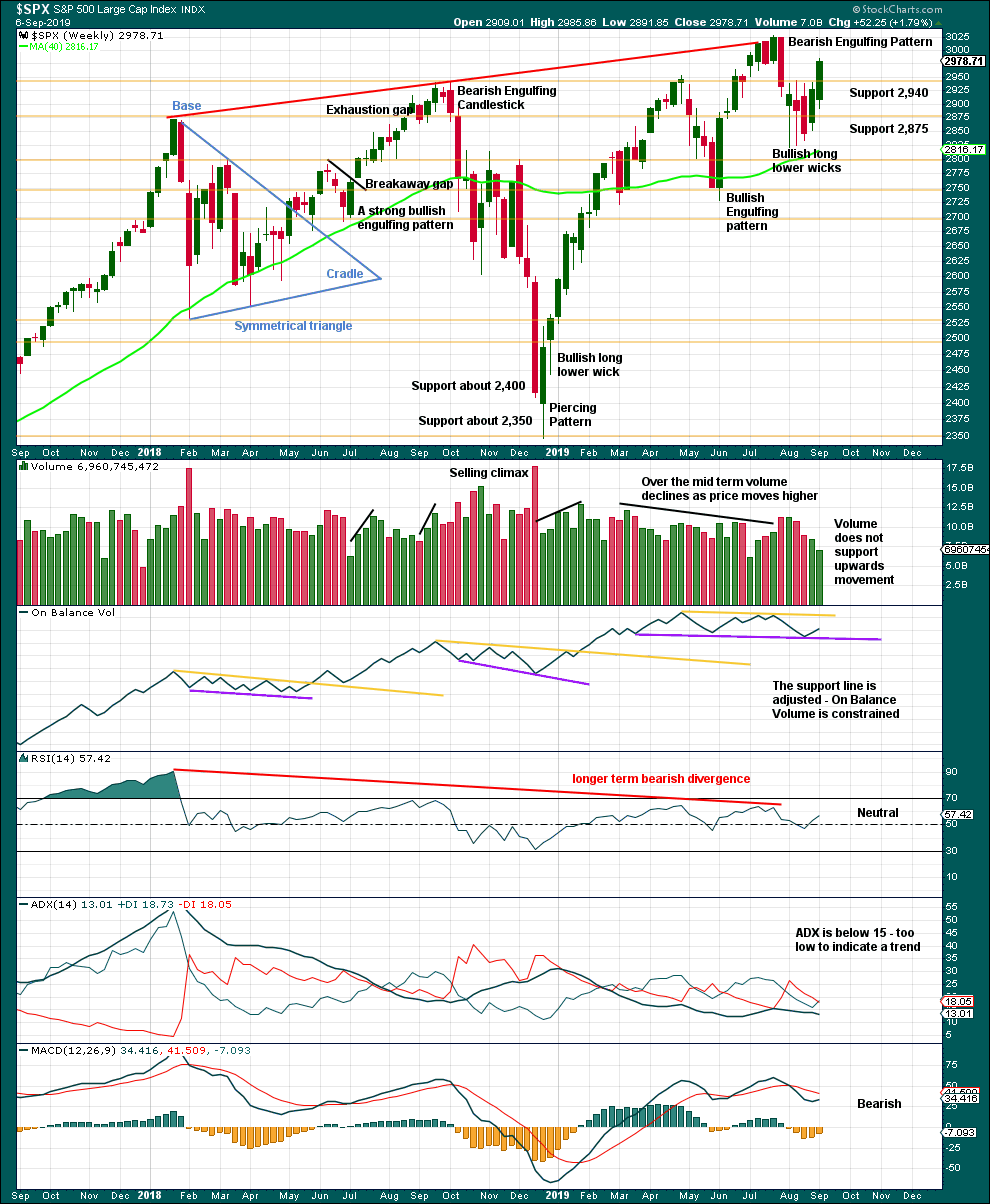
Click chart to enlarge. Chart courtesy of StockCharts.com.
Last week has effected an upwards breakout from a small range of the prior three weeks. While the breakout does not have support from volume at the weekly chart level, it does at the daily chart level for the day of the breakout.
DAILY CHART
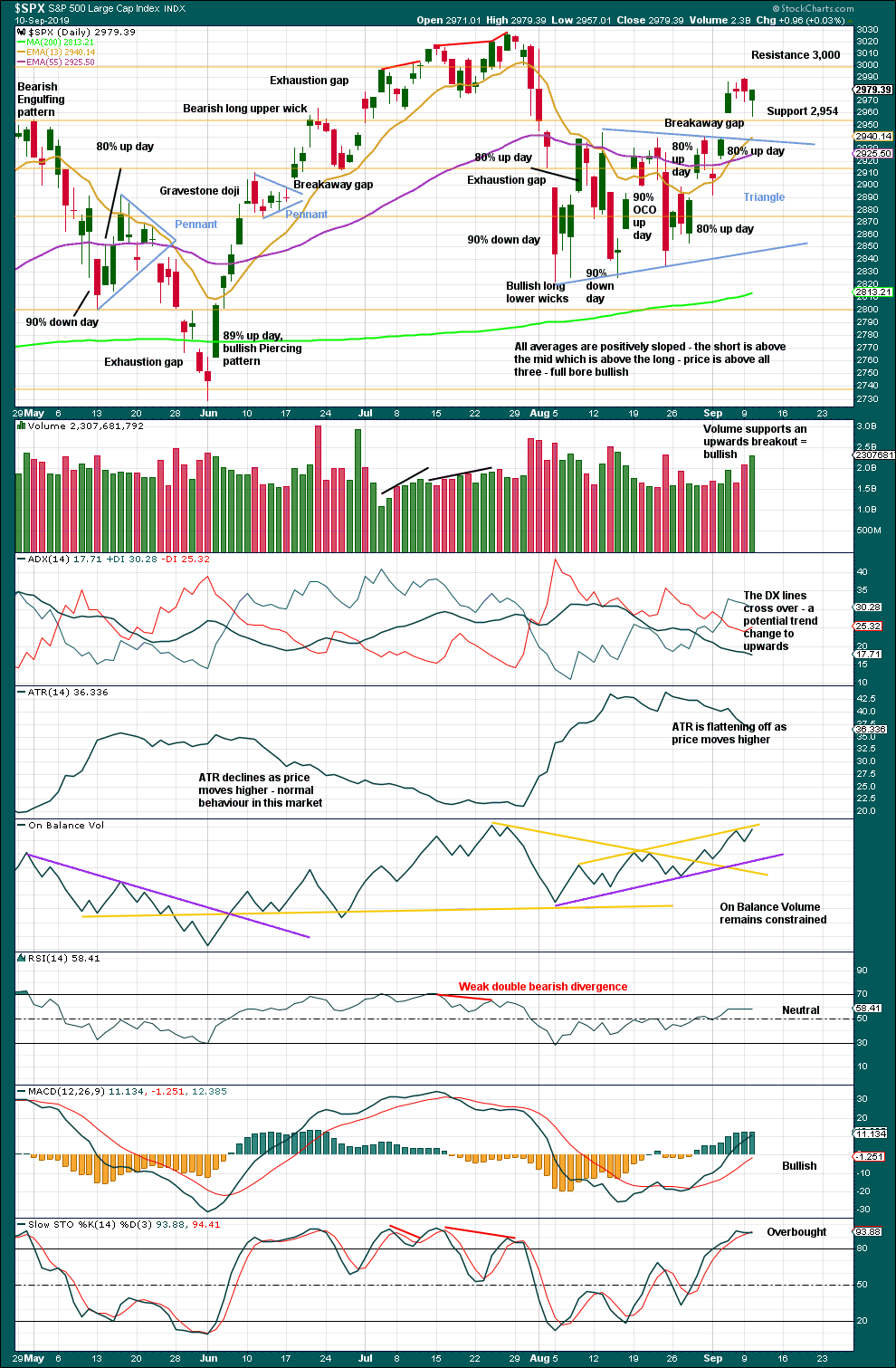
Click chart to enlarge. Chart courtesy of StockCharts.com.
The last low of the 15th of August was preceded immediately by a 90% downward day and followed immediately by a 90% OCO (Operating Companies Only) up day. This is a pattern commonly found at major lows, and it indicates a 180 degree shift in sentiment from bearish to bullish. This favours the main Elliott wave count.
Now the next low of the 23rd of August has been followed by two back to back 80% up days. This too is very bullish and favours the main Elliott wave count.
There is now an upwards breakout above the triangle pattern with support from volume and a breakaway gap. The breakaway gap may offer support at 2,938.84.
A target from the triangle pattern is 3,060.
Look for next resistance about 3,000.
The breakaway gap is providing support. This last daily candlestick is bullish with a long lower wick and a shaven head. Today looks like a very typical back test of support, it would be normal now to see price move up and away.
BREADTH – AD LINE
WEEKLY CHART
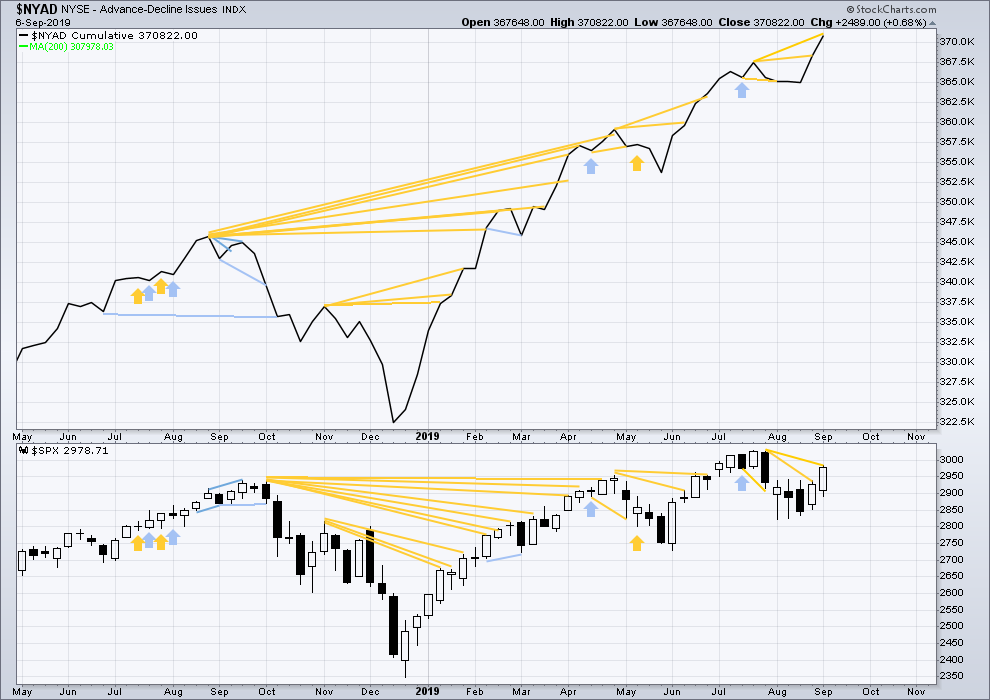
Click chart to enlarge. Chart courtesy of StockCharts.com. So that colour blind members are included, bearish signals
will be noted with blue and bullish signals with yellow.
Bear markets from the Great Depression and onwards have been preceded by an average minimum of 4 months divergence between price and the AD line with only two exceptions in 1946 and 1976. With the AD line making new all time highs again this week, the end of this bull market and the start of a new bear market is very likely a minimum of 4 months away, which is the beginning of January 2020.
In all bear markets in the last 90 years there is some positive correlation (0.6022) between the length of bearish divergence and the depth of the following bear market. No to little divergence is correlated with more shallow bear markets. Longer divergence is correlated with deeper bear markets.
If a bear market does develop here, it comes after no bearish divergence. It would therefore more likely be shallow.
Again, last week both price and the AD line have moved higher.
The AD line makes a new all time high. This is a very bullish signal and very strongly supports the Elliott wave count.
DAILY CHART
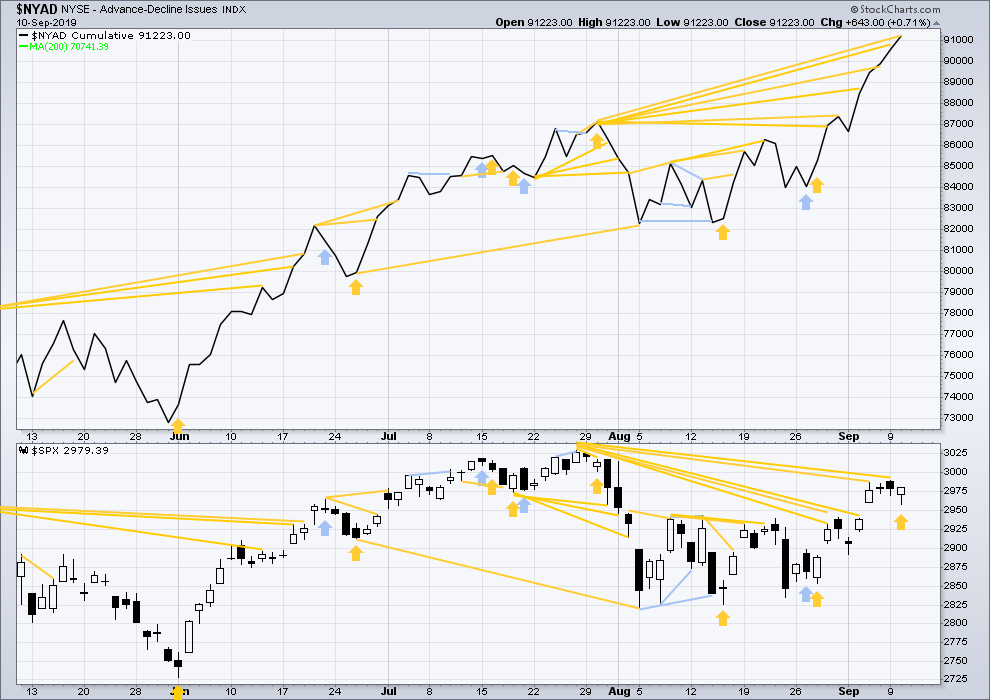
Click chart to enlarge. Chart courtesy of StockCharts.com. So that colour blind members are included, bearish signals
will be noted with blue and bullish signals with yellow.
Breadth should be read as a leading indicator.
Today price moved lower with a lower low and a lower high, but the AD line has moved higher to make yet another new all time high. This divergence is very bullish.
VOLATILITY – INVERTED VIX CHART
WEEKLY CHART
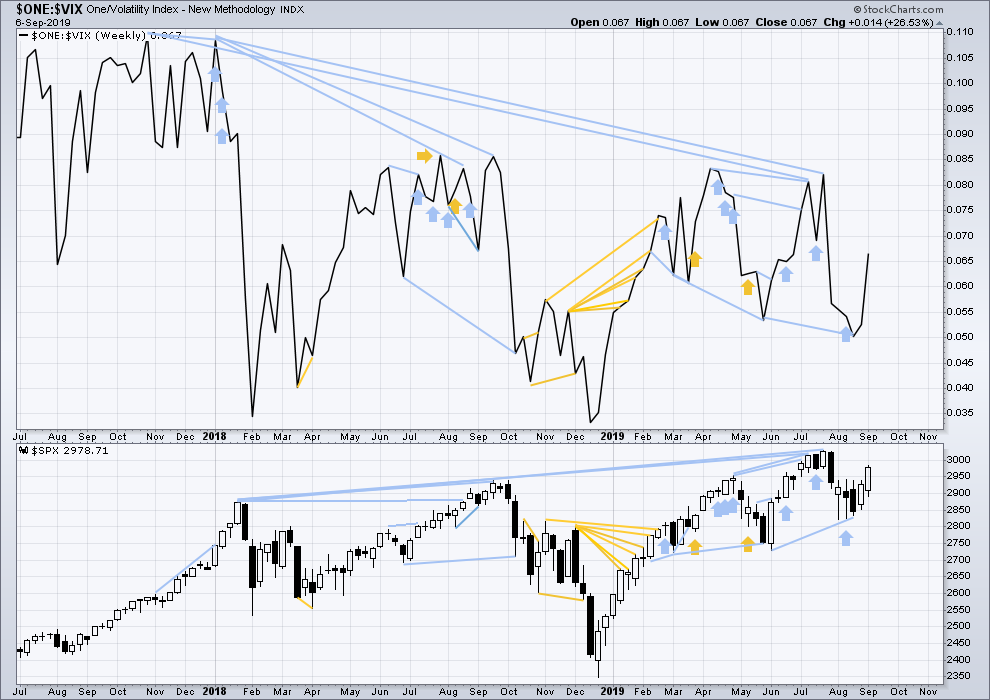
Click chart to enlarge. Chart courtesy of StockCharts.com. So that colour blind members are included, bearish signals
will be noted with blue and bullish signals with yellow.
The all time high for inverted VIX (which is the same as the low for VIX) was on 30th October 2017. There is now nearly one year and ten months of bearish divergence between price and inverted VIX.
The rise in price is not coming with a normal corresponding decline in VIX; VIX remains elevated. This long-term divergence is bearish and may yet develop further as the bull market matures.
This divergence may be an early warning, a part of the process of a top developing that may take years. It may not be useful in timing a trend change.
Last week both price and inverted VIX have moved higher. There is no new divergence.
DAILY CHART
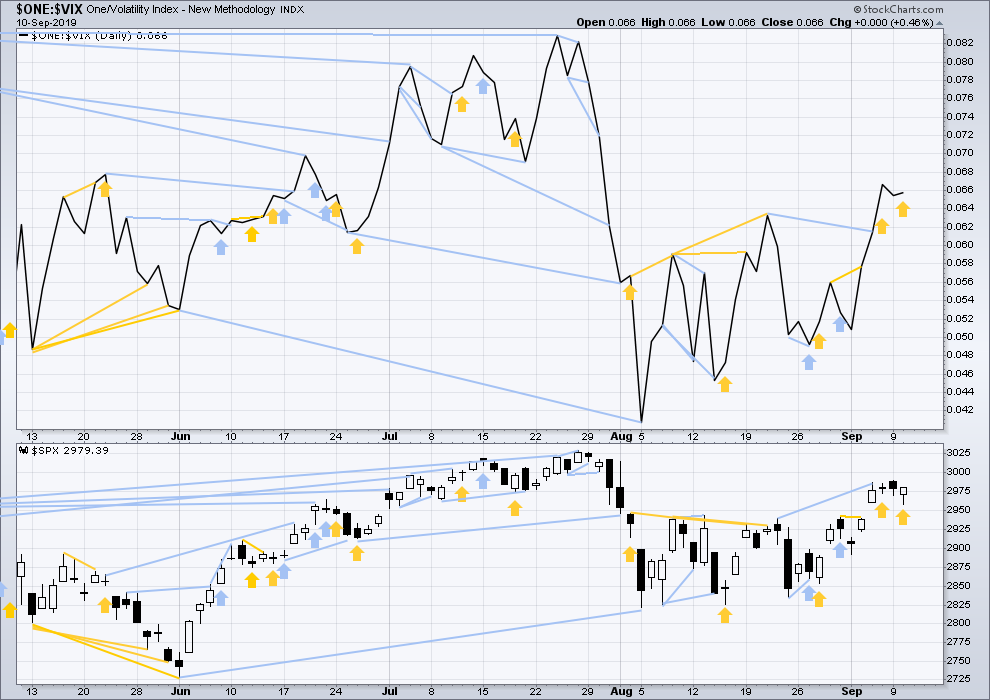
Click chart to enlarge. Chart courtesy of StockCharts.com. So that colour blind members are included, bearish signals
will be noted with blue and bullish signals with yellow.
Today price moved lower with a lower low and a lower high, but inverted VIX has moved higher. This divergence is bullish and shall be given a little weight as it confirms bullish divergence between price and the AD line.
DOW THEORY
Dow Theory confirmed a bear market in December 2018. This does not necessarily mean a bear market at Grand Super Cycle degree though; Dow Theory makes no comment on Elliott wave counts. On the 25th of August 2015 Dow Theory also confirmed a bear market. The Elliott wave count sees that as part of cycle wave II. After Dow Theory confirmation of a bear market in August 2015, price went on to make new all time highs and the bull market continued.
DJIA: 23,344.52 – a close on the 19th of December at 23,284.97 confirms a bear market.
DJT: 9,806.79 – price has closed below this point on the 13th of December.
S&P500: 2,532.69 – a close on the 19th of December at 2,506.96 provides support to a bear market conclusion.
Nasdaq: 6,630.67 – a close on the 19th of December at 6,618.86 provides support to a bear market conclusion.
With all the indices having moved higher following a Dow Theory bear market confirmation, Dow Theory would confirm a bull market if the following highs are made:
DJIA: 26,951.81 – a close above this point has been made on the 3rd of July 2019.
DJT: 11,623.58 – to date DJT has failed to confirm an ongoing bull market.
S&P500: 2,940.91 – a close above this point was made on the 29th of April 2019.
Nasdaq: 8,133.30 – a close above this point was made on the 26th of April 2019.
Published @ 09:56 p.m. EST.
—
Careful risk management protects your trading account(s).
Follow my two Golden Rules:
1. Always trade with stops.
2. Risk only 1-5% of equity on any one trade.
—
New updates to this analysis are in bold.


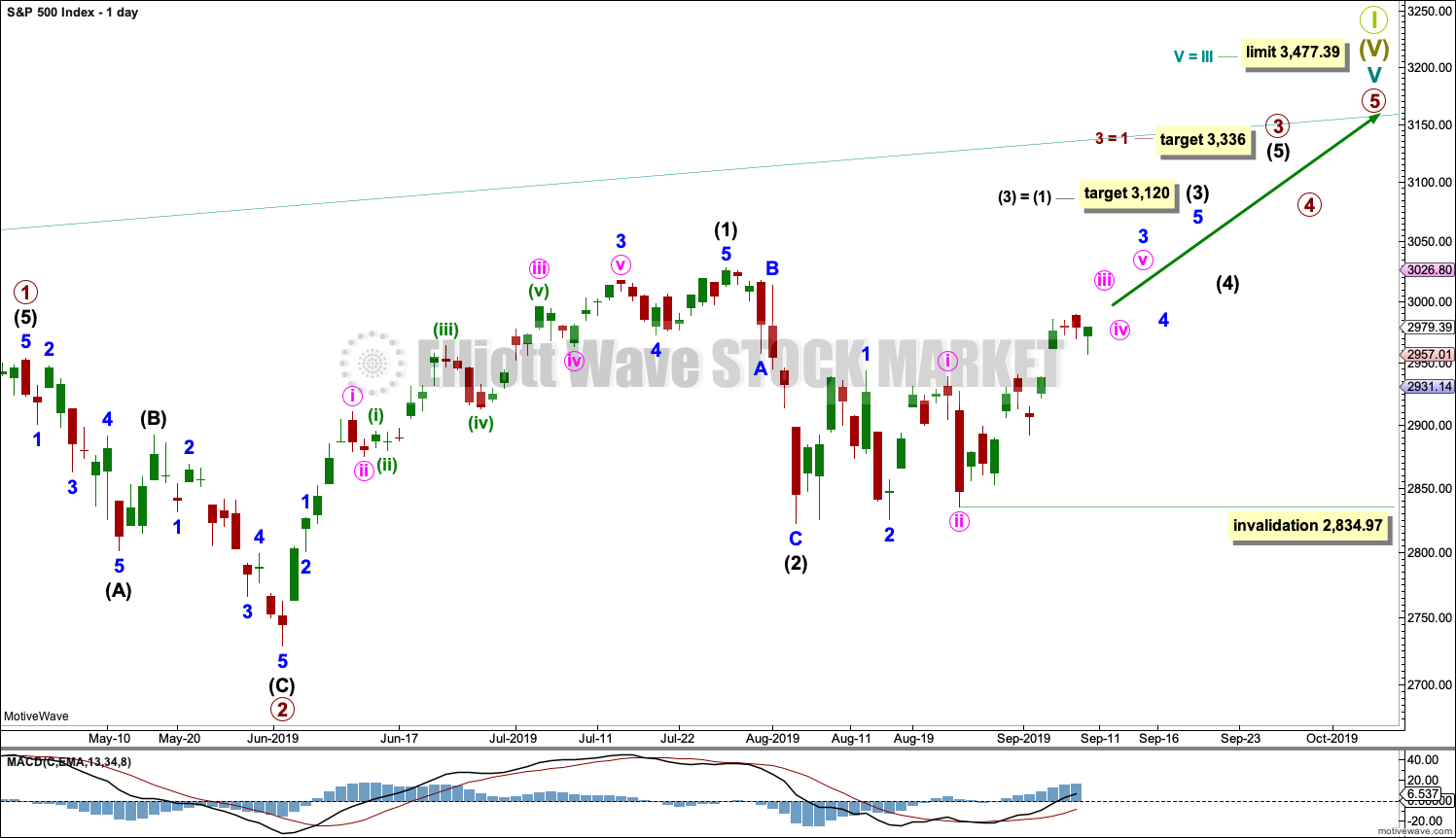

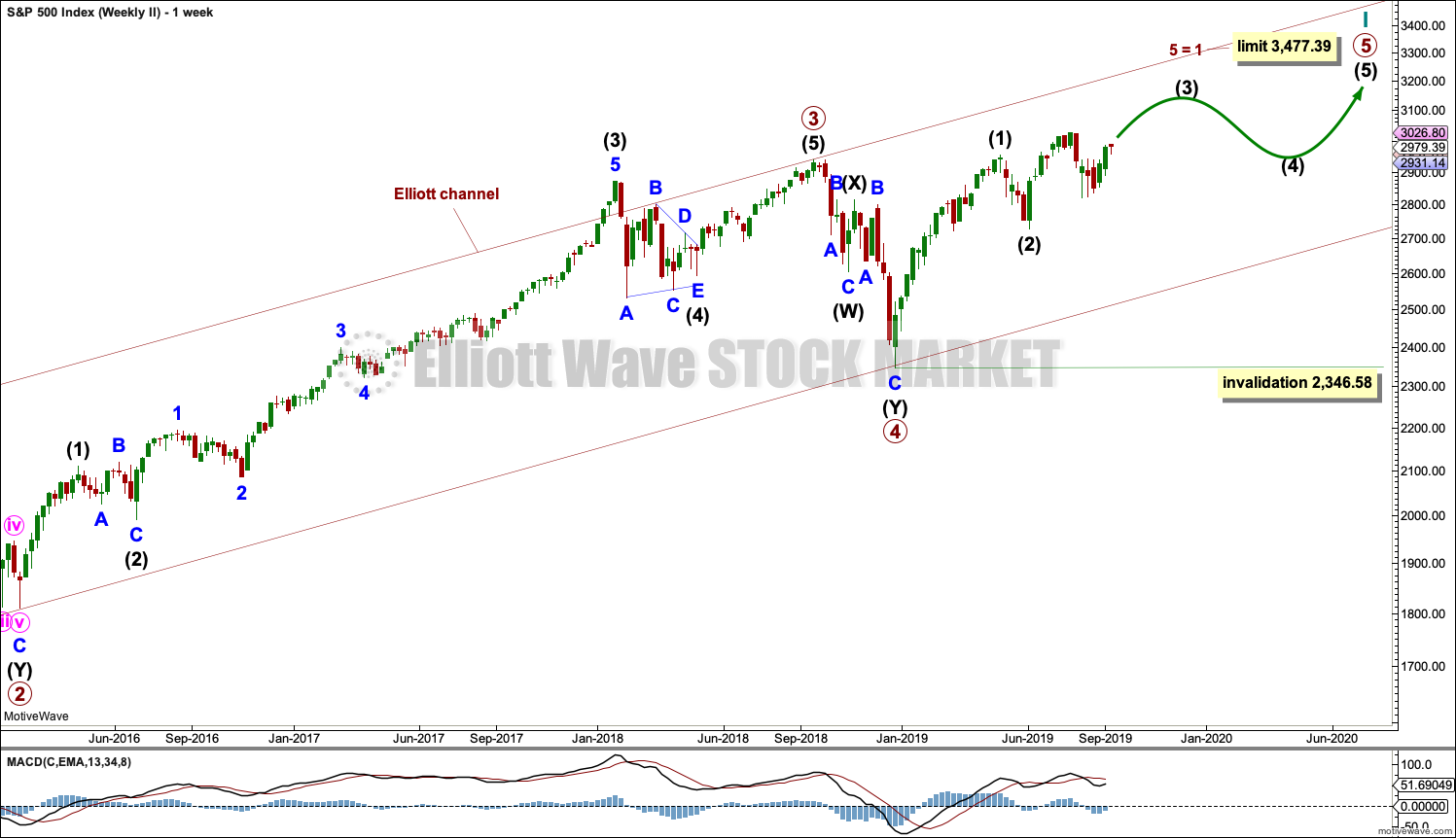
Remember that tomorrow is the 1st day of the roll for US equity futures, and December (Z9) becomes the front month!
Thanks for the reminder 🙂
Hourly chart updated:
Subminuette iii could now be over. The invalidation point remains the same for now.
So nice to have objective “EW + TA” only assessment! What I hear in the trading babble noosphere tends to be strongly “cannot trust this move! it’s a tweet driven market! it’s a pinball market! buying here would be chasing!”. Etc. It’s hard to listen too, honestly. And when you challenge these people to back their bearishness with analytics, all they can point to is “the old leaders aren’t leading here, so it’s all a false move”. Which I find pretty weak. Rotations happens. Anyway, thanks Lara for your fine work! A voice of objectivity in the wilderness…
You’re welcome Kevin.
I can’t find much bearishness in the charts for the short term. Breadth is way too strong to not trust this upwards move, it’s supported by underlying strength.
Future is within a hair of cash all time high… Tariff related of course. Could be a bullish end of week…
RUT is now starting to confirm this count, and the move up here is starting to show strong similarity to the intermediate 1, the massive Jan-Mar up-swing. That move is projected here (the longer/higher line up). If/as RUT breaks these recent highs (marked with green lines), that’s confirmation and then upside opportunity is quite significant. Remember RUT benefits hugely from dropping interest rates, lots of those companies have massive debt loads. That all said, RUT could swing back down and keep on doing the pinball mode over the next few months. I just think that’s somewhat lower in probability. Again, break out of the green levels is key.
look at the financials, after being rejected yesterday, this candle is making it look like XLF wants a lot higher
Agree but I’m always uncomfortable jumping on already extended moves. Maybe on a larger iv pullback. Remember XLF should lean bearish on falling interest rates (and it’s not doing that right now but it’s a caution).
What I did do (more sane or less I don’t know) is put on a mid October VIX bear put debit spread, 15-13.5. Risk is -$45 per option pair above 15 vs. +$105 max profit below 13.39. So 2.3 is max profit to max risk ratio, I like it, and it’s an expected result of our SPX wave count (steadily dropping vix).
Should be moving up now…
RUT getting long of tooth here, minuette iii looks like it’s approaching completion and 76-78% fibo’s just overhead at 1564-67. But nice run today!!! Got a nice bite with high delta IWM calls.
just sold rut futures for a good gain, still have half of my SPY calls looking for 300, maybe 300.70 today
Is RUT sweet and smooth, or what Peter? Lol!!! Right down to the 1 minute it tends to “run smooth” vs. SPX and NDX. And loving its recent vast out-performance. “Catching” up with the other averages a bit, an inter-average “reversion to the mean” in a sense.
As is my bad habit, I sold my RUT calls from the open “early”. But there’s nothing overly wrong with consistent bites out of the middle! RUT right at 78.6% now and a minuette iv back down to around 1642 seems quite possible here.
It is good to see RUT leading the way. Something that has been lacking.
In like Flynn
Dropping the deuce ….
Three Amigos.
But only one poncho.